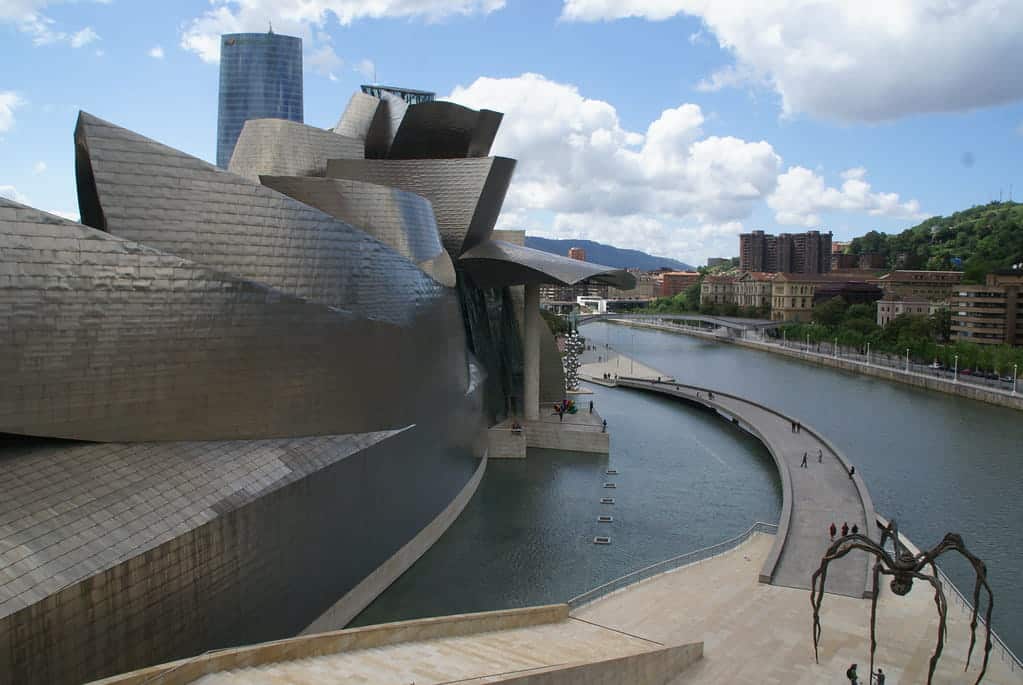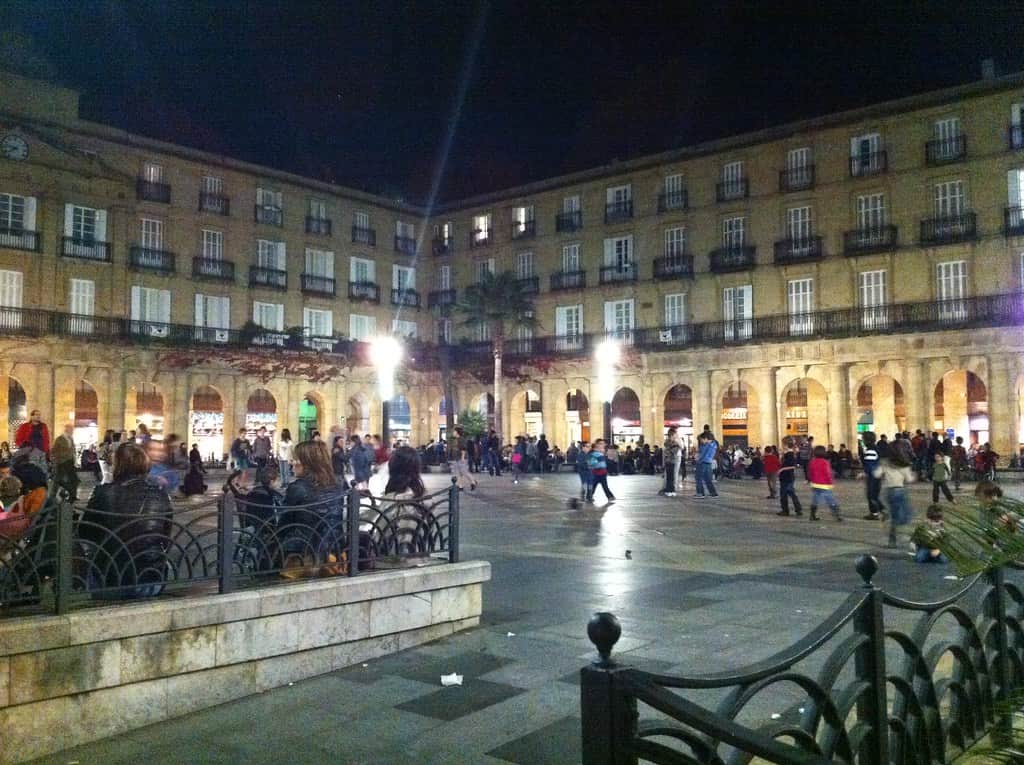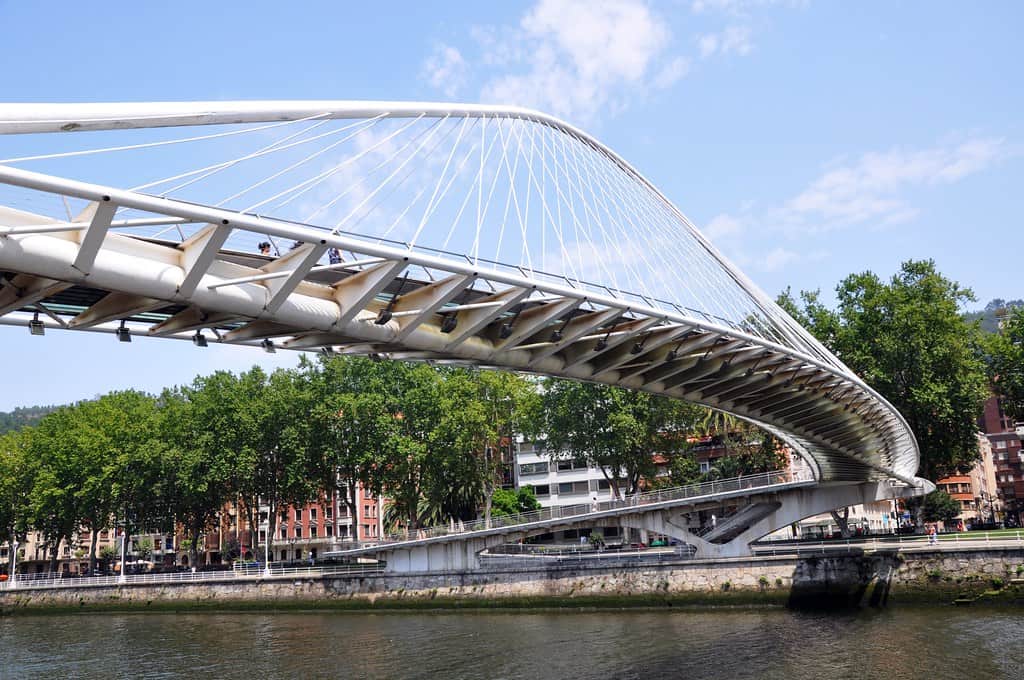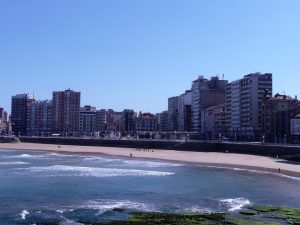
Bilbao, the capital of Biscay, is a city that embodies a fascinating blend of modernity and tradition. Known for its cutting-edge Guggenheim Museum, this city is a prime example of how culture and art can transform an industrial city into a thriving tourist and cultural hub.
But it’s not just modernity; its roots run deep in history, especially with its connection to the Camino de Santiago. This city is not only a meeting point for contemporary art lovers, but also for pilgrims walking the Northern Way, one of the routes of this important pilgrimage.
It offers pilgrims a rest on their journey to Santiago de Compostela, as well as the opportunity to explore its history, architecture, and exquisite cuisine. As experts in Camino de Santiago travel, we will explore the most emblematic sites of Bilbao, those places that no visitor should miss. You’ll understand why it continues to be a key stop on this millennial route.
Índice de contenidos [Ocultar]
Bilbao: A City of Contrasts Between Tradition and Modernity
Originally, it was a small town in the 14th century, but the city began to take shape around its estuary, which has been the axis of its economic and cultural development. The history of Bilbao is marked by its relationship with maritime trade, which fueled its growth and turned it into an important industrial centre in the region.
As it moved into the Middle Ages, the town began to grow in importance due to its strategic location and the commercial rights granted by the Lords of Biscay. The development of the steel industry in the 19th century radically transformed the landscape, and it became one of Spain’s leading industrial cities.
The 20th century brought significant challenges, including the devastation of the Spanish Civil War and the subsequent need for reconstruction. However, the second half of the century saw the city embark on a process of deindustrialisation and conversion towards more technological and service-oriented sectors.
The decision to build the Guggenheim Museum at the end of the 20th century symbolised this new phase, marking the beginning of an era of urban and cultural revitalisation that continues to this day.
Its port has been one of the economic engines of the city since its foundation. The estuary of Bilbao was not only a natural channel for maritime trade, but it also facilitated the development of heavy industry, especially steel and shipbuilding.
Why Choose the Northern Way?
The Northern Way is one of the most iconic routes of the Camino de Santiago. It offers a unique experience that combines stunning coastal landscapes, historic cities, and a rich gastronomic culture.
Unlike other routes, such as the Primitive Way from Lugo, it runs parallel to the Cantabrian coast. It provides panoramic views of the sea and a variety of terrains, ranging from beaches and cliffs to mountains and valleys.
One of the main reasons to choose the Camino de Santiago from Irún is its cultural and architectural diversity. Along the route, pilgrims pass through cities like San Sebastián, Gijón, and Santander. These cities offer a perfect blend of modernity and tradition, allowing visitors to enjoy monuments and museums without losing the essence of the pilgrimage.
While the Primitive Way is known for its challenging ascents and rural environment, this route combines the natural beauty of the coast with the accessibility of large cities.
Moreover, the Northern Way is ideal for those seeking a more peaceful and less crowded experience compared to the popular French Way. The route offers a closer connection with nature and allows pilgrims to enjoy less crowded trails, which facilitates greater introspection and personal connection during the journey.
On the other hand, routes like the Camino de Santiago from Ourense offer a more inland alternative, crossing Galicia and focusing the experience on Galician hospitality and its green landscapes. However, the Northern Way stands out for the opportunity to enjoy Cantabrian cuisine, renowned worldwide for its seafood and pintxos.
Choosing this route also means experiencing a path that has historically been important for maritime trade and the connection between regions.
Monuments and Must-See Places in Bilbao
Bilbao also offers a rich variety of landmarks that reflect both its historical legacy and its vibrant contemporary life. From iconic modern structures to historic corners that tell stories from the past, these are the places you can’t miss when you pass through here on your way to Santiago.
The Guggenheim Museum
The Guggenheim Museum is a symbol of the city’s transformation towards modernity. Designed by architect Frank Gehry, this stunning contemporary art museum is famous worldwide for its innovative titanium architecture. Its shape mimics the forms of ships and waves, reflecting the city’s maritime past.
It houses works by renowned international artists and is an indispensable cultural landmark.
Plaza Nueva and the Old Town

Plaza Nueva is a neoclassical square filled with bars and restaurants where you can enjoy the famous Bilbao pintxos. The surrounding area is a maze of narrow streets full of history, old shops, and more traditional bars, offering a glimpse into the local life of the past.
Santiago Cathedral and its Connection to the Camino
Yes, there is also a Santiago Cathedral here. It is located in the Old Town, and as you can imagine, it is one of the most important pilgrimage sites on the Northern Way. Although more modest than its namesake, this Gothic cathedral is a key site for pilgrims passing through Bilbao, offering a space for reflection and spirituality.
The Zubizuri Bridge and Doña Casilda Park

The Zubizuri Bridge, designed by Santiago Calatrava, is another architectural gem you can find here. This white pedestrian suspension bridge gleams over the Bilbao estuary, connecting Campo de Volantín with the Ensanche. Nearby is the Doña Casilda Park, a green oasis in the city centre, perfect for a relaxing stroll or a picnic outdoors.
The Ribera Market
Located by the estuary, the Ribera Market is the largest covered market in Europe and a gathering point for food lovers. With its lively atmosphere, it offers all kinds of local fresh products, from seafood to vegetables and meats, as well as a variety of stalls where you can taste Basque cuisine on the spot.
The Bilbao Fine Arts Museum
The Bilbao Fine Arts Museum is one of the most important cultural institutions in Spain. It houses an extensive collection of art spanning from the 12th century to the present day, including masterpieces by artists such as El Greco, Goya, and Picasso. In addition to its permanent collection, it organises temporary exhibitions that highlight different artistic movements and emerging artists.
Its classical architecture contrasts harmoniously with the modern structures of the city, offering a space for reflection and artistic admiration that is a must for any visitor.
Azkuna Zentroa
Previously known as Alhóndiga Bilbao, Azkuna Zentroa is a multifunctional centre that combines culture, leisure, and sport in one place. Designed by famous architect Philippe Starck, the building is an artwork in itself, with a glass façade and metal structures giving it a cutting-edge look.
Inside, you’ll find a library, exhibition halls, a gym, cinemas, and a rooftop with gardens and panoramic views of the city.
The Artxanda Funicular
To enjoy the best panoramic views of the city, the Artxanda Funicular is a must-visit. This funicular takes you from the city centre to Mount Artxanda, at an altitude of 267 metres, offering spectacular views of the estuary, the Guggenheim Museum, and the city skyline.
At the top, you’ll find a viewpoint perfect for photography, as well as picnic areas and walking trails.
Bilbao Cuisine: A Taste of Tradition
Bilbao’s cuisine is a window into the soul of the Basque Country, offering intense flavours and culinary traditions that date back centuries.
The pintxos are much more than Basque tapas; they are an institution and a reflection of the local passion and creativity for food. Served in bars and taverns, these small bites can be as simple as a skewer of olives and anchovies or as elaborate as a miniature haute cuisine dish.
You’ll find a wide range of restaurants serving both traditional Basque dishes and innovative plates that fuse global influences with local products.
For pilgrims on the Camino de Santiago, Bilbao offers numerous options to enjoy nourishing and comforting meals that replenish the energy needed to continue the journey. Many restaurants and bars are used to hosting pilgrims and offer daily menus at reasonable prices, which include local dishes like cod al pil-pil and porrusalda (leek soup).
Tips for Your Visit to Bilbao
To make the most of your time in Bilbao, it’s important to keep a few practical details in mind that can make your trip more comfortable and enjoyable. Here are some tips on the best time to visit, how to get around the city, and what to expect from the local weather.
- The best time to visit is between May and October, when the weather is warmer and rainfall is less frequent. During these months, the city comes alive with various festivals and cultural events. The most notable is Semana Grande in August, which features concerts, fireworks, and cultural events that attract both locals and visitors.
- The city has an efficient public transport system that includes the metro, tram, and buses.
-
- The metro is especially useful for quickly getting around the city and its surroundings, with lines connecting the city centre to the suburbs and nearby beaches.
-
- The tram, on the other hand, offers a scenic way to explore the city centre and reach landmarks such as the Guggenheim Museum and the Old Quarter.
-
- The climate is oceanic, meaning it can be quite humid and variable. Rain is common throughout the year, so it is advisable to carry an umbrella or a waterproof jacket, regardless of the season.
-
- In summer, temperatures are typically mild, around 25°C, but evenings can be cool, so it’s advisable to bring a long-sleeved item of clothing.
-
- During the winter, temperatures are cooler but rarely extreme, so a good coat, scarf, and gloves will be sufficient to keep you comfortable.










 Hello, would you like more information?
Hello, would you like more information?